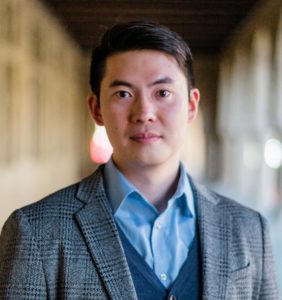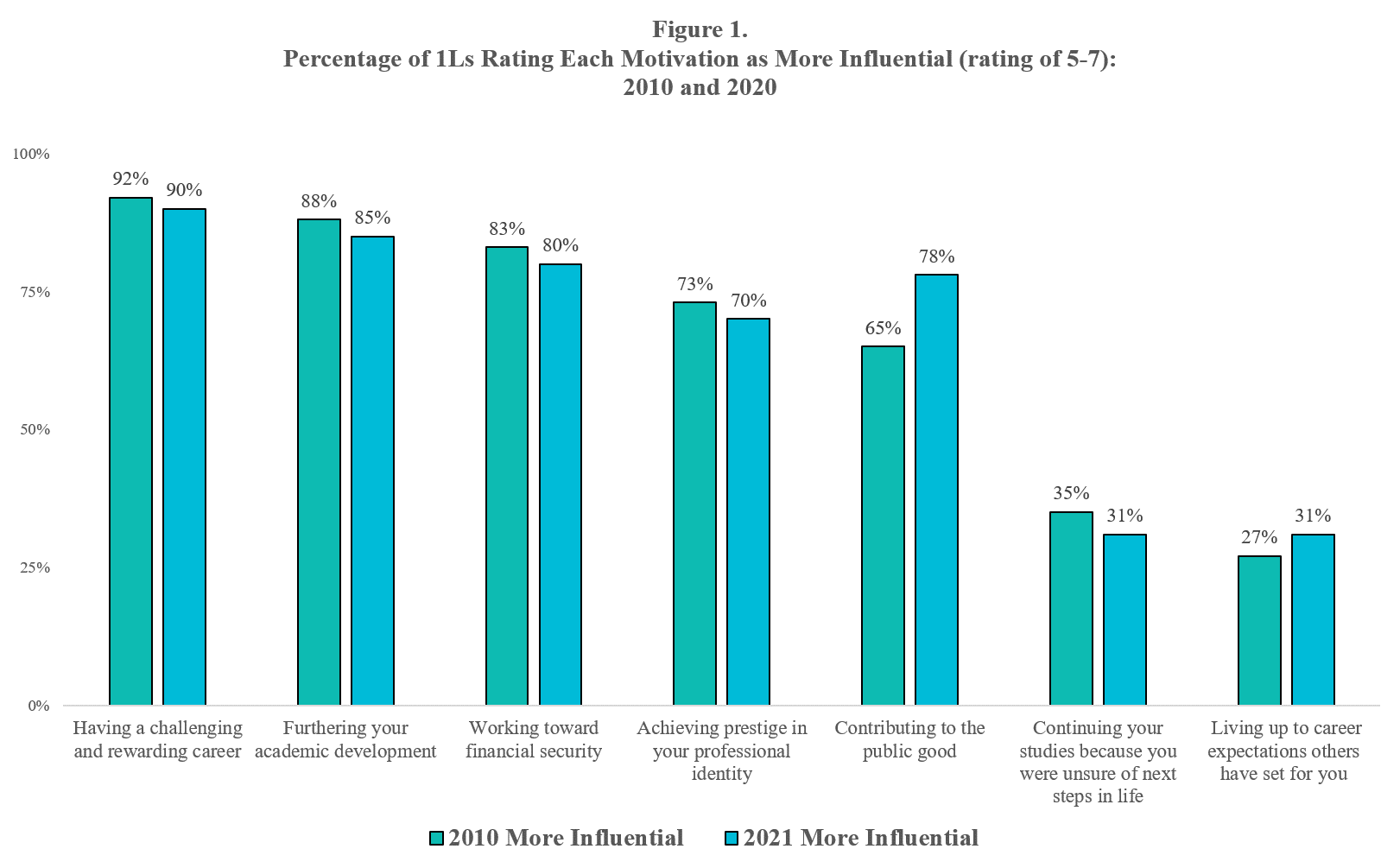Guest Post: Why Motivations Matter Revisited: More So Now
Guest Post: Why Motivations Matter Revisited: More So Now

Stephen Daniels
Senior Research Professor
American Bar Foundation

Shih-Chun Chien
Research Social Scientist
American Bar Foundation
In an earlier LSSSE guest blog post, we argued for greater attention to student motivations – to why people choose to attend law school and make a career in law.[1] We weren’t talking about just-so ideas of motivation like the “Trump bump”[2] or the escapist idea of avoiding a sour job market.[3] Such explanations, we said, “strip any real substance out of the idea of motivation, telling us little about the decision to attend law school and nothing meaningful about the choice of law as a career – and ultimately, this is the important issue.”[4]
We noted that “literatures in psychology and on organizations suggest that motivations can be important for understanding the outcomes of legal education, especially graduates’ career aspirations.”[5] Motivations become intelligible to the extent we can connect them to what students hope to do as lawyers.[6] The earlier blog was just the opening of a larger interest in motivation and the utility of LSSSE survey data, and this one furthers both.
Two LSSSE surveys are unique for exploring those motivations and career aspirations. One is older -- the 2010 LSSSE survey, and one newer -- the 2021 LSSSE survey. In addition to the full suite of annual survey questions (which included questions related to aspirations), each asked seven motivation questions to a subset of the survey participants. Those questions asked students to rate each of the seven motivations on seven-point scale from “not at all influential” to “very influential.”
We delved into the 2010 motivation data just a bit in the earlier blog to illustrate the range of student motivations and their relative importance (4,626 respondents, 22 law schools) and we return to them here.[7] Figure 1 below shows the seven motivation questions and their relative importance for the students in the 2010 motivation subset. The percentages are for 1L respondents only -- they are closest to the decision to attend law school. Most important for the 2010 respondents are the intrinsic, inward looking, motivations of “a challenging and rewarding career” and “furthering one’s academic development.” The extrinsic, outward looking, motivation of “contributing to the public good” is much less important.

In a subsequent paper we began exploring that connection between motivations and aspirations using the same 2010 data.[8] Our interest there is in the links among motivations, preferred area of legal specialization,[9] and working in the criminal justice system, especially those wanting to work in a prosecutor’s office (or alternatively, in a public defender’s office).[10]
Viewed through the lens of motivation, those students in the 2010 motivation subset interested in criminal law saw contributing to the public good as a more influential motivation than did their peers interested in some other area of legal specialty. Their non-criminal law peers saw working toward financial security financial security as more influential.
Revealing a sharper contrast are the students interested in corporate and securities as their area of legal specialty. They are, in a sense, mirror opposites of the criminal law students in being driven much less by the public good, driven much more by financial security, and somewhat more by prestige. Only 39% of those interested in corporate/securities see public good as more influential compared to 72% for those interested in criminal law. The two groups of students clearly value different things and have different aspirations.
Having worked with the 2010 data and wanting something more contemporaneous, we asked the LSSSE administrators if they could add those seven motivation questions to the 2021 survey, and they generously did so. Those seven questions were asked to a subset of the 2021 survey participants (2,930 respondents, 15 law schools).
The 2010 data, while important in and of themselves, are just a snapshot in time. In wanting the 2021 data the key question for us is one about stability v. change. Are there any noticeable changes in student motivations, the interactions among motivations, and their connections to student aspirations? If so, what might help explain any change. The general patterns over time in the LSSSE data for job expectations would suggest relative stability rather than change.[11] Events in the broader societal environment since 2010 might suggest otherwise.[12] Our initial thought is the null hypothesis of no real change in motivations, which while generally the case isn’t in one important way. That exception involves the motivation of contributing to the public good.
Not only about the 2010 respondents, Figure 1 also presents a simple comparison of responses to the seven motivation questions in 2010 and in 2021 by 1L students.[13] The bars represent the percentage who reported that a motivation was more influential for them (a rating of 5, 6, or 7 on the seven-point scale). At first glance one sees a relatively stable pattern between 2010 and 2021, with small decreases in the degree of influence. The intrinsic motivations of a challenging career and academic development remain the most intense motivations followed by financial security.
One thing, however, stands out in an otherwise expected pattern of relative stability. Public good – an extrinsic motivation that is of particular interest to us – disturbs that pattern. Rather than the very slight decrease for the substantive motivations (all aside from “unsure of next steps” and “others’ expectations”), its influence is more important in 2021. Its influence became more important than prestige and close to that for financial security.
Digging a bit deeper into the data, we found that this increase does not appear to be just a matter of some general increase in the importance of public good. Instead, it is a matter of the intensity of the influence, and this is the most interesting finding. Again, the percentages in Figure 1 includes those giving a rating 5, 6, or 7. If we break that figure down, we see that the percentages for ratings 5 and 6 are essentially identical for the two years. For 2010, rating 5 = 17% and for 2021, rating 5 =17%. For 2010, rating 6= 17% and for 2021, it is 16%. For the highest, most intense rating we find 32% in 2010 and 45% in 2021. There is no comparable increase in intensity for the other substantive motivations (the greatest was for financial security, from 43% to 46%).
While our analyses looking at the characteristics of the students and schools involved in the two surveys are continuing, there are two matters worth noting concerning the public good, change, and intensity. Although quite different, both are instructive. The first involves gender. Female respondents rate the public good as more influential than their male counterparts in both surveys. For both groups, however, intensity increased as reflected in the percentage rating it at the highest ranking. In 2010, 37% of female respondents rated public good as very influential, while 23% of males did. In 2021, the percentages were 49% and 30%, respectively.
The second involves a very different way of looking at change and intensity – comparing students in particular schools rather than students in general. Two schools appeared in each motivation subset, allowing us to at least explore this. Because of the way in which LSSSE prepared the two data sets for us (using a unique code for each participating school that does not allow us to identify the school), we were able to find two schools appearing in 2010 and in 2021. For one of the schools the percentages of responding students rating public good at the highest level in each year are 25% and 41%, respectively. For the other school the comparable percentages are 20% in 2010 and 34% in 2021. Important here, as with gender, is not the exact percentages themselves (although those figures are not, of course, unimportant), but the idea of change in intensity even if the starting points were different. In short, something appears to be going on regarding student motivations.
Our comparative findings concerning change, though quite preliminary at this point, reinforce the importance of motivation for the study of legal education and the legal profession. An influx of students highly motivated by contributing to the public good has implications for both. It may shift the dynamics of the legal employment and increase the pool of graduates who aspire to much needed public service careers. At the same time, it means that law schools will need to provide the educational opportunities and support for those students to succeed, something not always the case. This could include working more closely with public service employers to provide needed opportunities and support.
___
[1] Stephen Daniels & Shih-Chun Chien, “Beyond Enrollment: Why Motivations Matter to the Study of Legal Education and the Legal Profession,” Guest Post, LSSSE Blog, September 24, 2020, ), https://lssse.indiana.edu/blog/guest-post-beyond-enrollment-why-motivations-matter/.
[2] Stephanie Francis Ward, “The ‘Trump Bump’ for Law School Applicants is Real and Significant, Study Says,” ABA Journal, February 22, 2018, https://www.abajournal.com/news/article/the_trump_bump_for_law_school_applicants_is_real_and_significant_survey_say; Karen Sloan, “Forget the ‘Trump Bump:’ First-Year Law School Enrollment Dipped in 2019,” December 12, 2019, Law.Com, https://www.law.com/2019/12/12/forget-the-trump-bump-law-school-enrollment-dipped-a-bit-in-2019/.
[3] Louis Toepfer, “Introduction,” in Seymour Warkov and Joseph Zelan, Lawyers in the Making (1965); at xv.
[4] Supra note 1 at 2.
[5] Id at 4.
[6] Id at 5.
[7] See supra note 1 at 6.
[8] Shih-Chun Chien & Stephen Daniels, “Who Wants to be a Prosecutor? and Why Care? Law Students’ Career Aspirations and Reform Prosecutors’ Goals,” Howard Law Journal (forthcoming 2022), using 2010 data to explore connections among motivations, preferred area of legal specialization, and preferred work setting upon graduation.
[9] The 2010 LSSSE survey asked students to choose from a list of 26 areas of legal specialization for their preferred area of specialization upon graduation.
[10] The analysis includes the issues of diversity and gender. One interesting finding is that African-American males interested in criminal law are more likely to eschew work as a prosecutor or as a public defender in favor of private practice. AAPI students are the least likely cohort to choose criminal law as their area of specialization.
[11] The Changing Landscape of Legal Education: A 15-Year LSSSE Retrospective (2020) at 9, https://lssse.indiana.edu/wp-content/uploads/2015/12/LSSSE_Annual-Report_Winter2020_Final-2.pdf.
[12] We are particularly interested in whether the rise and proliferation of progressive prosecutors and other recent civil justice reform/Black Lives Matter-type movements and anti-Asian hate crimes affect law students’ motivations and career aspirations.
[13] Our earlier blog reported on 1Ls who rated each motivation in 2010 at 6-7 (the two highest ranks). Here Figure1 reports on respondents who rated each motivation at 5-7. This is consistent with the approach we used in supra note 9. It also allows us to accentuate the changing intensity for motivations.

